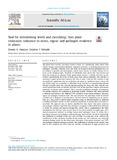| dc.description.abstract | The global food security and plant resources levels are continuously under threat from climate change, environmental pollution, population pressure, co-evolving plant pests and pathogens. Currently, scientists across the world are in pursuit of plant genotypes that can be resilient in growth and development amidst these stresses to enable survival of humans in the changing times. Therefore, to effectively select plants that have known and favorable resistance or tolerance levels against these stresses, a reliable tool that can determine quantitatively the levels of these good traits during evaluation and selection is necessary in plant protection. However, the lack of such a tool has left scientist to rely on qualitative approaches that are subjective and prone to significant errors. Hence, the aim of this study was to develop an algorithm based tool that can quantitatively estimate selected desirable traits. The research question guiding the study was; how will the estimated quantitative levels of selected desirable traits by the algorithm compare with known properties of selected plant varieties? This is because quantitative strategies of estimation are usually objective and consistent in producing outputs. Therefore, this article presents a software tool known as the OMATEC-HTVP calculator of host plant resistance, tolerance, vigour and pathogen virulence levels. The tool calculates the percentage levels of selected variables and is designed to classify them. The tool works by integrating any six parameters of a crop, plant or hybrid under evaluation using its infected,stressed or improved (modified) treatment relative to their uninfected,unstressed or parent check treatment respectively. The approach uses an infused modified five step omatec host plant resistance and pathogen virulence algorithm. The calculator is designed in Microsoft® Excel 2010 and is availed for training and research through this article's link as supplementary file. After, development the tool was used on test data of two plant varieties of napier grass (Pennisetum purpureum) infected by Ustilago kamerunensis pathogen: Clone 13 variety had a host plant resistance and pathogen virulence/damage levels of 9.8% and 90.2% respectively. The coefficient of variation of the data used of Clone 13 variety was 12.4%, whereas the classification of the calculated variables of the variety was low resistance and very high virulence/damage levels. On the other hand, Kakamega 2 host plant resistance was 59.1% and pathogen virulence/damage was 40.9%. The coefficient of variation of the variety's data used in the calculator was 8.4%, with the variables classification of high resistance and moderate virulence/damage levels. In conclusion, the tool's outputs using the test data was consistent with the general characteristics of the varieties. Further, the mathematical logic used to develop it appears clear based on principle of relative performance of biological systems and the unique property of logarithmic functions to assign similar output values in evaluation of relative performances of treatments that increase by a certain magnitude, without discriminating the units used in measuring various parameters. | en_US |
| dc.subject | Tool, determining levels ,classifying, host plant, resistance, tolerance ,stress, vigour pathogen, virulence, plants | en_US |

